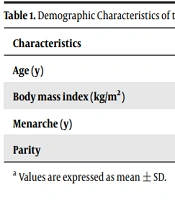Dear Editor,
Endometriosis is one of the most common diseases in women of reproductive age. This disease is the endometrial tissue space outside the uterine cavity that responds to steroid hormones in monthly cycles (1). Endometriosis can cause adhesions, local inflammation, dysmenorrhea, dyspareunia, chronic pelvic pain, and infertility (2). Dyspareunia is one of the most common complaints of these patients that is superficial (pain at the entrance to the vagina) or deep (deep pain during deep intercourse) (3). Dyspareunia affects the sexual life of patients by decreased intimacy, libido, and sexual arousal (4).
In previous studies, surgical interventions in endometriosis have improved dyspareunia and the sexual quality of life; nevertheless, the improvement of sexual function, and not only the reduction of pain at intercourse, should be considered the primary clinical goal of endometriosis treatment (5).
This cohort study was conducted on married female subjects of reproductive age with endometriosis who were candidates for laparoscopy in an academic center affiliated with Tehran University of Medical Sciences, Tehran, Iran, within January 2019 to March 2020. The sexual quality of life was measured before and 3 months after the intervention. The exclusion criteria were the lack of definitive proof of endometriosis, pain with a source other than the disease, and history of pelvic surgery or pelvic mass other than endometriosis.
The questionnaires used in this study included the female sexual function index (FSFI), Female Sexual Distress Scale, and Numeric Analog Scales (NAS) that assessed the pain felt by the patient within a range of 0 - 10 points. Totally, 69 married female subjects entered the study. Table 1 shows the demographic characteristics of the participants.
Dysmenorrhea, persistent pelvic pain, and pain during defecation were observed in 88, 34, and 29% of the patients. In addition, dyspareunia, infertility, and fear of intimacy were noticed in 62, 58, and 23.2% of the participants. The duration of infertility in the affected couples was at least 1 year and maximum 11 years.
The estimated mean values of sexual stress before and after the surgery were 45.38 ± 5.2 and 20.37 ± 1.3, respectively. The mean values of pain scores during sex before and after the intervention were 6.46 ± 3.2 and 3.0 ± 1.6, respectively. The FSFI mean scores before and after the surgery were 31.6 ± 5.1 and 71.5 ± 2.8, respectively, confirming that sexual satisfaction and performance indicators have significantly improved after the surgery with less pain, more desire and arousal, and more lubrication and satisfaction.
As previously mentioned, sexual function in women is a multifactorial process that includes psychological and sexual dimensions (5). Furthermore, women might show different reactions to dyspareunia, such as sex avoidance, dealing with the pain during sex to keep sexual intimacy, or fear of pregnancy (6), which have a devastating effect on their quality of life.
In conclusion, numerous young women with endometriosis experience dyspareunia that surgery can improve. In the treatment of such patients, it seems that a multidisciplinary team consisting of gynecologists, sexologists, and psychologists can play a better role in the improvement of their quality of life.
